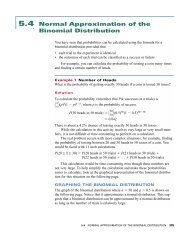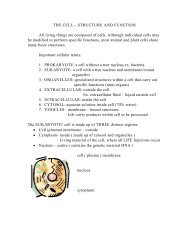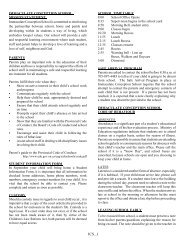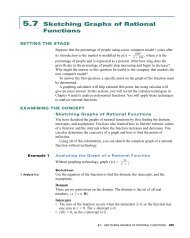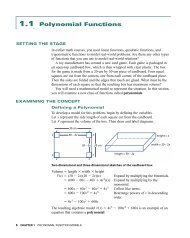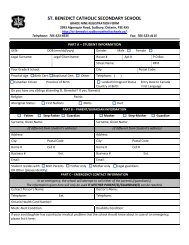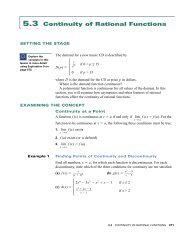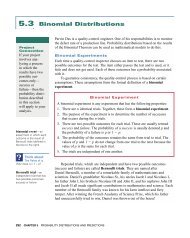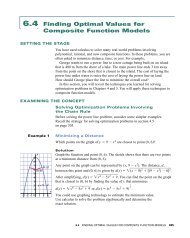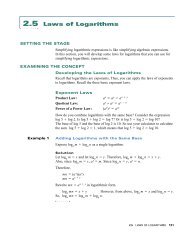Pg 225
Pg 225
Pg 225
You also want an ePaper? Increase the reach of your titles
YUMPU automatically turns print PDFs into web optimized ePapers that Google loves.
h(t) 4.9t 2 1.5t 17<br />
h′(t) lim<br />
h → 0<br />
lim<br />
h → 0<br />
lim<br />
h → 0<br />
lim<br />
h → 0<br />
lim<br />
h → 0<br />
lim<br />
h → 0<br />
lim<br />
f (t h) f (t)<br />
<br />
h<br />
[4.9(t h) 2 1.5(t h) 17] [4.9t 2 1.5t 17]<br />
<br />
h<br />
4.9(t 2 2th h 2 ) 1.5(t h) 17 [4.9t 2 1.5t 17]<br />
<br />
h<br />
4.9t 2 9.8th 4.9h 2 1.5t 1.5h 17 4.9t 2 1.5t 17<br />
<br />
h<br />
9.8th 4.9h 2 1.5h<br />
<br />
h<br />
h 1 (9.8t 4.9h 1.5)<br />
<br />
h<br />
1<br />
20.0<br />
(9.8t 4.9h 1.5) 10.0<br />
h → 0<br />
c′(t) = 1.5t<br />
0.0<br />
d′(t) = 0<br />
9.8t 4.9(0) 1.5<br />
9.8t 1.5<br />
The derivative of the original<br />
function, f (t), is the sum of the<br />
derivatives of the component<br />
functions, b(t), c(t), and d(t).<br />
f (t) b(t) c(t) d(t)<br />
4.9t 2 1.5t 17<br />
f ′(t) b′(t) c′(t) d′(t)<br />
9.8t 1.5<br />
Value of Derivative<br />
–10.0<br />
–20.0<br />
–30.0<br />
0.4 0.8 1.2 1.6 2.0 2.4<br />
Time (s)<br />
f ′(t) = b′(t) + c′(t) + d′(t)<br />
f′(t) = b′(t) + c′(t) + d′(t)<br />
= –9.8t + 1.5<br />
b′(t) = – 9.8t<br />
The derivative of a sum is<br />
the sum of the derivatives.<br />
The Sum Rule<br />
If h(x) f (x) g(x) and f and g are both differentiable, then<br />
h′(x) f ′(x) g′(x). In Leibniz notation,<br />
d<br />
d<br />
[ f (x) g(x)] d<br />
[ f (x)] d<br />
[g(x)].<br />
d<br />
d<br />
x<br />
x<br />
x<br />
Proof<br />
Let F(x) f(x) g(x).<br />
h ′(x) lim<br />
h → 0<br />
lim<br />
h → 0<br />
lim<br />
h → 0<br />
F(x h) F(x)<br />
h<br />
f (x h) f (x)<br />
h<br />
lim<br />
h → 0<br />
f ′(x) g′(x)<br />
[ f (x h) g(x h)] [ f (x) g(x)]<br />
<br />
h<br />
[f (x h) f (x)] [g(x h) g(x)]<br />
<br />
h<br />
lim<br />
h → 0<br />
g(x h) g(x)<br />
h<br />
Rearrange the numerator.<br />
Rewrite using the<br />
sum rule for limits.<br />
226 CHAPTER 3 RATES OF CHANGE IN POLYNOMIAL FUNCTION MODELS



